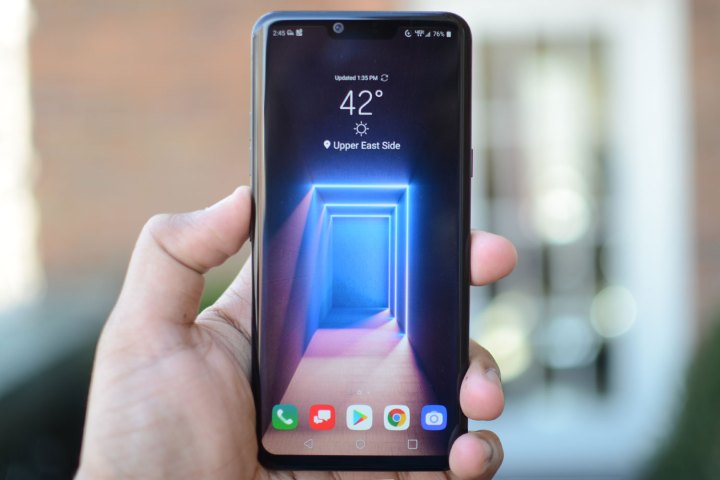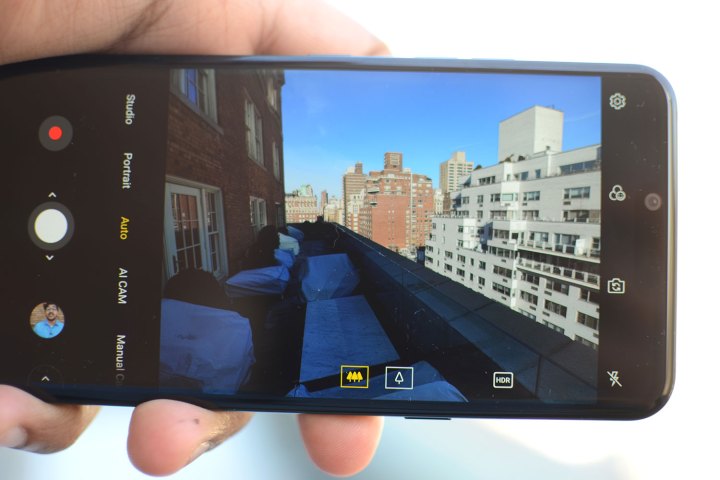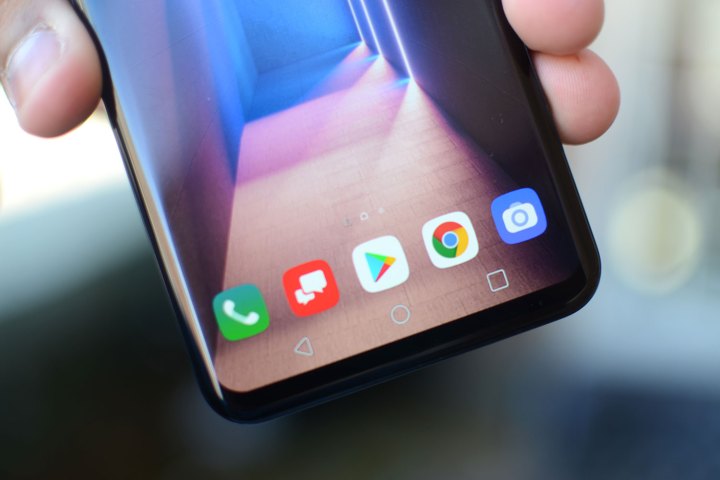
We’ve seen a flurry of phones unveiled at MWC 2019, including two new flagships from LG. The LG G8 ThinQ is the release we expected, but it was joined by the slightly bigger LG V50 ThinQ. Both are packing some impressive hardware, but there are some differences worth highlighting if you’re considering buying either of these phones. Let’s take a look at exactly how they measure up as we pit LG G8 ThinQ versus LG V50 ThinQ to pick a winner.
Specs
| LG G8 ThinQ |
LG V50 ThinQ | |
| Size | 151.9 × 71.8 × 8.4 mm (5.98 × 2.83 × 0.33 inches) | 159.2 x 76.1 x 8.3 mm (6.27 x 3 x 0.33 inches) |
| Weight | 167 grams (5.89 ounces) | 183 grams (6.46 ounces) |
| Screen size | 6.1-inch AMOLED | 6.4-inch AMOLED |
| Screen resolution | 3,120 × 1,440 pixels (564 pixels per inch) | 3,120 x 1,440 pixels (537 pixels per inch) |
| Operating system | Android 9.0 Pie | Android 9.0 Pie |
| Storage space | 128GB | |
| MicroSD card slot | Yes, up to 512GB | Yes, up to 512GB |
| Tap-to-pay services | Google Pay | Google Pay |
| Processor | Qualcomm Snapdragon 855 | Qualcomm Snapdragon 855 |
| RAM | 6GB | 6GB |
| Camera | Dual-lens ultra-wide-angle 16-megapixel, and standard 12MP with OIS rear, dual lens 8MP and TOF front | Triple-lens ultra-wide-angle 16-megapixel, standard 12MP with OIS, and telephoto 12MP with OIS rear, dual lens 8MP and wide-angle 5MP front |
| Video | 2,160p at 60 frames per second, 1,080p at 60 fps, 720p at 240 fps | 2,160p at 60 frames per second, 1,080p at 240 fps |
| Bluetooth version | Bluetooth 5.0 | Bluetooth 5.0 |
| Ports | USB-C port, 3.5mm audio jack | USB-C port, 3.5mm audio jack |
| Fingerprint sensor | Yes, on back | Yes, on back |
| Water resistance | IP68 | IP68 |
| Battery | 3,500mAh
QuickCharge 3.0 Qi wireless charging |
4,000mAh
QuickCharge 3.0 Qi wireless charging |
| App marketplace | Google Play Store | Google Play Store |
| Network support | AT&T, Verizon, T-Mobile, Sprint | T-Mobile, AT&T, Verizon, Sprint |
| Colors | Carmine red, new Aurora black, new Moroccan blue | Astro black |
| Price | TBA | TBA |
| Buy from | LG | LG, Sprint |
| Review score | Hands-on | Hands-on |
Performance, battery life, and charging
While both these phones feature the soon to be ubiquitous Snapdragon 855 processor, only the V50 ThinQ has the optional X50 5G modem onboard, which allows for 5G connectivity. As both devices also have 6GB of RAM, we’d expect broadly similar performance. They also both have 128GB of storage with room for expansion via a MicroSD card slot.
The LG V50 ThinQ has a bigger, 4,000mAh battery, while the LG G8 ThinQ makes do with 3,500mAh, but the V50 has a slightly bigger screen to power, not to mention power-hungry 5G connectivity when you can get it. Both support Quick Charge 3.0 wired charging and Qi wireless charging.
Winner: LG V50 ThinQ
Design and durability
- 1. LG G8 ThinQ
Apart from the size difference — the LG G8 ThinQ is slightly smaller and lighter — there isn’t much to separate these phones. They are both curved glass sandwiches with notches in the screen, small chins at the bottom of the front, and horizontal camera modules on the back with fingerprint scanners below. Only the V50 gets a yellow, light-up 5G logo on the back.
They both score IP68 ratings, which means they can take a dip without sustaining lasting damage, but we’d advise a case for whichever one you choose.
Winner: Tie
Display

Both these devices are blessed with beautiful AMOLED screens. The LG G8 ThinQ has a 6.1-inch display and the LG V50 ThinQ has a 6.4-inch display. Both sport a resolution of 3,120 x 1,440 pixels and an aspect ratio of 19.5:9 with a notch cut out the top to house the front-facing cameras. These are high-quality screens and you’ll struggle to see any difference between them. The winner here really comes down to which size you prefer.
Winner: Tie
Camera

LG multiplied the number of lenses in its smartphone cameras in recent releases and the G8 and V50 are no exception to this trend. The V50 features a triple-lens setup which includes a standard 12-megapixel lens with an f/1.5 aperture and optical image stabilization (OIS), alongside a 16-megapixel ultra wide-angle lens with an f/1.9 aperture, and a 12-megapixel telephoto lens with an f/2.4 aperture and OIS. In certain markets, the LG G8 ThinQ will have the same triple-lens suite, but the handset we got our hands on only had a dual-lens setup and lacked the telephoto lens.
There are differences around front, too. The G8 ThinQ pairs a wide-angle 8-megapixel lens with a Time of Flight sensor which enables secure face unlock, Hand ID, and Air Motion gestures. You can lock and unlock your G8 without touching it, and you can even control video, volume, or take calls by waving your hand above that front-facing camera suite, which LG calls Z Camera. It could prove handy if you’re in the habit of trying to use your phone with wet or dirty hands, but it could also prove to be a gimmick that you don’t use.
The LG V50 ThinQ pairs a regular 8-megapixel lens with a wide-angle 5-megapixel lens. The V in the V50 stands for video, and we expect it to have some smart video options. One special trick it has up its sleeve is the ability to take video portraits which automatically blur the background in videos, giving you a nice bokeh effect, but this works on the G8 ThinQ as well.
The triple-lens camera is going to be more versatile than the dual lens, because the extra telephoto lens enables 2x optical zoom. Which of the front-facing cameras you prefer depends on your tastes, but the V50 will likely offer some advantages in the video department.
Winner: LG V50 ThinQ
Software and updates

You’ll find LG’s user interface running on top of Android 9.0 Pie here and there’s not going to be much difference in your experience between these two phones. The LG G8 ThinQ has the Z Camera and the V50 has some video extras. We’d expect them to receive software updates and new versions of Android on a similar schedule.
Winner: Tie
Special features

Apart from its video smarts, LG is also going to offer a second screen accessory for the V50, though we don’t know what it will cost. It’s a bit like a cover case, but it contains a second 6.2-inch OLED screen, so you could watch a movie on one screen while you text on the other. It’s not exactly a folding phone, but some people might be tempted. You’ll also enjoy 5G connectivity on the LG V50 ThinQ, provided you have a 5G network in your neck of the woods.
The LG G8 ThinQ has the Z Camera as its headline special feature with face unlock, Hand ID, and the Air Motion gestures.
Winner: LG V50 ThinQ
Price and availability
We don’t yet know the price of either of these phones, but we expect the LG G8 ThinQ to cost less than $800 and the LG V50 ThinQ to be more expensive. In terms of availability, the LG G8 ThinQ should be available soon, whereas the LG V50 ThinQ won’t land until the summer. Verizon will definitely offer both phones, Sprint may have the V50 ThinQ as an exclusive for a short period, and we know T-Mobile will carry the LG G8 ThinQ. Keep an eye on our LG V50 and G8 buying guide for the latest news.
Overall winner: LG V50 ThinQ
These are two very similar phones, so your final decision could well boil down to size and budget preferences. The 5G support gives the V50 ThinQ an edge, and if you’re sizing up the triple-lens camera suite against the dual-lens camera suite, then we think that’s another point in the V50’s favor, but it feels like the gap between LG’s flagship ranges is surprisingly small this year.




